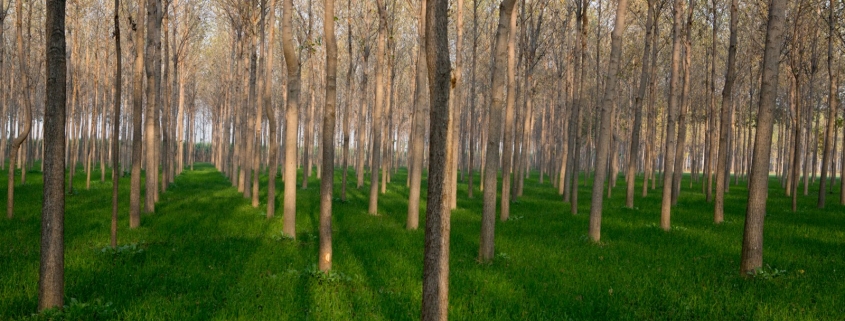Humans have made the planet greener, and why that could be a mixed blessing
“Humans are officially greening the earth,” says the headline about a study by Boston University environmental researchers. It then asks, “Is that a good thing?”
NASA satellites show the world is literally getting greener as reforestation projects and intensified agriculture have spread vegetation across more land. While this sounds like progress, experts note that not all vegetation is equal in the effort to fight climate change.
The study, published in the journal Nature Sustainability, reveals human influence on the earth’s vegetation. Vegetation, in turn, affects water and carbon cycles. Because farming, logging, tree planting, and other land uses have different effects on atmospheric carbon, it’s important to create models for understanding how “leafiness” can help or hinder efforts to limit greenhouse gasses. Professor Ranga Myneni and his team at Boston University studied satellite data from the last twenty years and found that global “green leaf area” has increased by five percent since the early 2000s.
The world’s most populous countries, China and India, are leading the greening trend. The increased vegetation has two main sources: massive tree-planting programs in China, and intensive agriculture in both China and India. Although other areas in the world, such as the Amazon or eastern North America, have more vegetation, they don’t show a similar increase.
“China and India account for one-third of the greening, but contain only 9 percent of the planet’s land area covered in vegetation.” That’s according to lead author Chi Chen of Boston University. “That is a surprising finding, considering the general notion of land degradation in populous countries from overexploitation.”
Of the Earth’s vegetative areas, some 30 percent are getting greener, while five percent are getting browner. In China, farming accounts for 32 percent of increased vegetation. In India, farming makes up 82 percent of leaf cover. The amount of land dedicated to food production in China and India has not changed much in the last 20 years, but food production has swelled up to 40 percent since 2000. That’s because farming methods have intensified in order to meet growing demand for food. The added greening comes from using the same land for multiple crops and multiple yearly harvests and heavy use of fertilizers and irrigation.
The researchers suggest that greening achieved through agriculture doesn’t offer the same benefits to the climate as reforestation because carbon absorbed by crops is soon released back into the atmosphere. Reforestation is the other leading factor in global vegetation increase, notably in China, with its massive tree-planting program called the Green Great Wall.
After years of economic development and rapid growth, urbanization and deforestation were blamed for the degradation of important watersheds and other natural resources. China’s Green Great Wall is similar to tree regrowth and sustainable forestry methods in Europe. Forest vegetation is a key factor in reducing climate change emissions, according to reports over the last couple of years. Large-scale reforestation efforts in China, India and South Korea have already shown significant carbon removal benefits to the climate over the last two decades. In 2017, the president of the research firm Forest Climate Analytics said, “The experience of China—which produces more carbon emissions than any other country—is especially noteworthy, as reforestation programs there not only removed CO2 from the atmosphere and increased forest cover by more than 50 percent, but also provided additional income to rural communities and ensured that forests provide critical ecosystem services that support agricultural productivity.”
The recent study on global greening used data from NASA’s Terra and Aqua satellites, whose MODIS sensors recorded up to four shots of nearly every spot on Earth each day for the past 20 years. NASA research scientist Ramakrishna Nemani, said the long-term data provided greater insight into the role humans play in the vegetation of the earth. “When the greening of the Earth was first observed,” he said, “we thought it was due to a warmer, wetter climate and fertilization from the added carbon dioxide in the atmosphere. Now with the MODIS data, we see that humans are also contributing.”
The Boston University group concluded that human land use is a “key driver of the ‘Greening Earth,’ accounting for over a third of the observed net increase in green leaf area. The study revealed a significant gap in understanding how that fits into the carbon cycle. “Moving forward,” the researchers said, “we recommend that Earth system models be refined to include key human land-use practices identified by our work—such as crop rotation, irrigation, and fertilizer use, fallowing and abandonment of land, afforestation, reforestation, and deforestation—all of which influence atmospheric carbon in different ways.”
Eileen Wray-McCann is a writer, director and narrator who co-founded Circle of Blue. During her 13 years at Interlochen Public Radio, a National Public Radio affiliate in Northern Michigan, Eileen produced and hosted regional and national programming. She’s won Telly Awards for her scriptwriting and documentary work, and her work with Circle of Blue follows many years of independent multimedia journalistic projects and a life-long love of the Great Lakes. She holds a BA and MA radio and television from the University of Detroit. Eileen is currently moonlighting as an audio archivist and enjoys traveling through time via sound.





Leave a Reply
Want to join the discussion?Feel free to contribute!